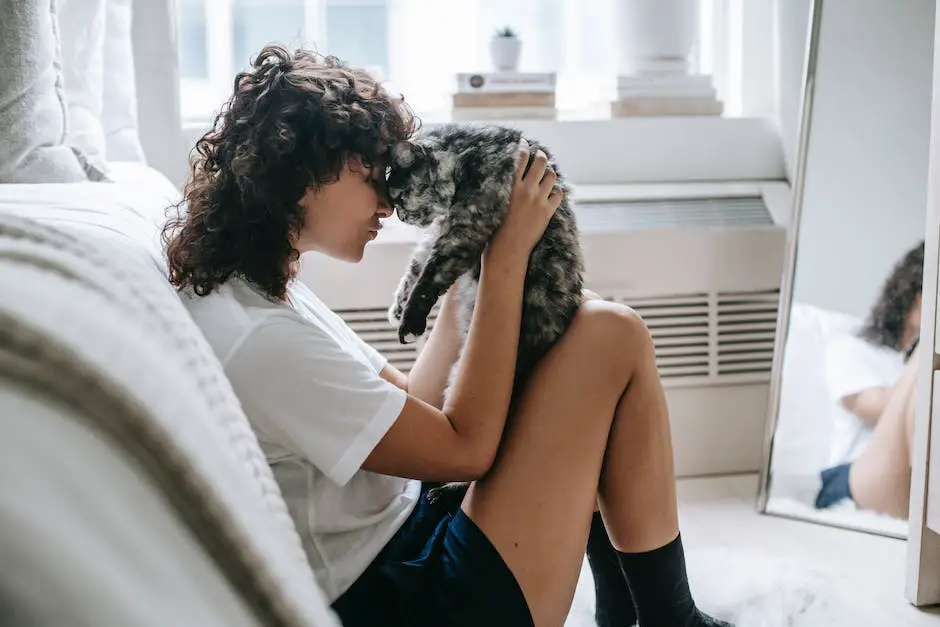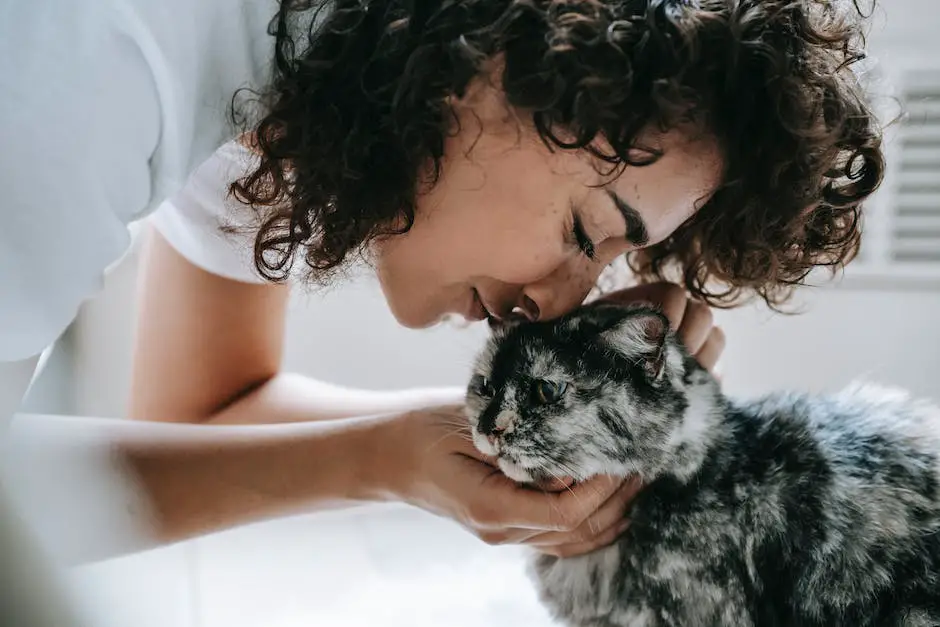When a cat goes into heat, she becomes restless and more vocal than usual. She may also urinate more frequently. This can last for several days and typically happens every three to four weeks.
The average cat will stay in heat for 7-10 days, but some may stay in heat for up to three weeks.
How do I get my cat out of being in heat?
There are a few things you can do to help calm your cat during heat:
-Introduce catnip: Catnip is an herb that can have a calming effect on cats. You can give your cat a small amount of catnip to help ease their anxiety.
-Play with your cat: Spending time playing with your cat can help them to feel more relaxed and calm.
-Get a heating pad: A heating pad can provide your cat with some comfort and help to ease their anxiety.
-Use Feliway: Feliway is a product that releases a calming pheromone that can help to calm your cat.
-Keep your cat away from male cats: If possible, try to keep your cat away from any male cats. This will help to reduce their anxiety and stress levels.
-Keep your cat indoors: Keeping your cat indoors can help to reduce their stress levels.
-Go to the vet: If your cat is having difficulty calming down, it may be best to consult with your veterinarian. They can provide you with additional tips and advice on how to help your cat during heat.
Female cats reach sexual maturity and can breed from about 4 months old. They will then come into heat (or season) every year around February to October. Female cats have many short periods roughly 2-3 weeks apart. They do not ovulate until they are mated, so this period of heat cycles can be lengthy.
How long does it take for a cat to get off heat
A cat’s estrous cycle is the time when she is fertile and can mate. The estrous cycle lasts for about 3 to 7 days, but can last as long as 20 days for some cats. Cats go into heat quite often, so if you have a female cat, be sure to keep an eye on her and keep her away from male cats if you don’t want her to get pregnant.
It is unclear whether or not heat cycles are painful to cats, but from the symptoms they exhibit, it would appear that they are very uncomfortable. A kitten can have her first heat as early as 4 1/2 months, so don’t wait until six months to spay.
What triggers cat heat?
The hormonal cycle of free-roaming cats is triggered by sunlight. This is why kitten season is typically from May to June. You’ll notice female cats beginning their cycles of heat in near February when the days start to become longer. They’ll be less likely to go into heat when the days become shorter and darker in the fall.
It’s important to note that your cat’s personality shouldn’t change much after she’s spayed. She may seem a bit more reserved, but that’s because her hormones aren’t fluctuating like they used to when she was in heat.
Do female cats bleed when in heat?
In the vast majority of cases, cats don’t bleed when they’re in heat. Blood in their urine or around the genital area could be a sign of a urinary tract infection, so if you do spot any blood, be sure to contact your vet right away.
When a female cat is in heat, she may urinate more frequently or even spray urine on vertical surfaces. This is because her urine contains both pheromones and hormones, which act as signals of her reproductive status to other cats. This is why queens in heat attract tomcats (intact male cats).
Why has my cat been in heat for 2 months
If your cat is displaying symptoms of persistent estrus (continued heat cycles without a break), this could be a sign of an underlying health issue such as ovarian cysts. It’s important to have your cat examined by a veterinarian so that the cause can be properly diagnosed and treated.
Your cat is feeling extra affectionate during a heat because she is looking for a mate. She will rub against furniture and people, particularly with her hindquarters, and may often display the mating position with her hindquarters and tail raised. If you don’t want her to mate, you should keep her away from other cats and make sure she is spayed.
How do you tell if a cat is in heat for the first time?
If your cat is acting flirtatious, extra-affectionate, or vocalizing excessively, they may be in heat. Other signs include raising their hindquarters and moving their tail from side to side. If you suspect your cat is in heat, it’s best to consult a veterinarian for advice on how to proceed.
Cats experience a surge of hormones during their estrus cycle, which can make them extra attentive and even affectionate towards their humans. However, they do not experience any cramps or other physical symptoms during this time.
When should female cats be spayed
There is no definitive answer as to when is the best time to spay or neuter your cat. It generally depends on the preference of the Veterinarian or owner. Some Vets recommend spaying or neutering as young as six to eight weeks of age, while others recommend waiting until the kitten is five to six months old. Ultimately, the decision is up to the owner, but it is important to consult with a Vet beforehand to make sure that your cat is healthy enough for the surgery.
Some people believe that spaying or neutering their dog or cat will cause them pain. However, during the surgery, animals are fully anesthetized and feel no pain. After the surgery, some animals may experience some discomfort. However, this is typically not severe and can be managed with pain medication.
How long do you have to keep a cone on a cat after being spayed?
It is important to keep the cone on for the recommended time in order to allow the site to heal properly. Once the sutures and staples are removed, the healing process should be complete. If there are any other lesions that have not healed completely, they may require more time to heal properly.
Unfortunately, at this time, there is no safe, tested, and approved method of sterilizing cats without surgery. Trap-Neuter-Return is still the Gold Standard. Currently, Trap-Neuter-Return is the only option that meets all of the requirements and needs of feral cats.
Does catnip help cats in heat
Rescue remedy and catnip are two popular herbal remedies for cats in heat. Rescue remedy can help calm your cat down while catnip may have a calming effect on them as well. However, it’s important to only use these remedies in moderation and not overuse them. If your cat is still acting agitated, talk to your veterinarian about other options.
Female cats in heat release a powerful sex pheromone that can be smelled by a male from a distance of a mile away. This pheromone is used to attract mates and is strongest during the estrus cycle.
Do female cats in heat pee on things
Cats in heat can be very vocal, and they may howl loudly and constantly in an attempt to attract a male. They may also spray walls or furniture with strong-smelling urine to indicate their availability to a male.
There is an unmistaken odour that comes with having an intact or un-neutered male cat. This pungent, ammonia-like smell is him signalling to all the ladies that he is available and ready to go. It is coming from his skin, urine and any spraying that he may do as well.
How long do cats act crazy in heat
Your kitten is going through a normal stage of development called estrus, or “heat.” She will show some unusual behaviors during this time, including excessive meowing. This is normal behavior and nothing to worry about. Your kitten will outgrow this phase and eventually settle down.
Some cats exhibit what is called “silent heat.” The cats are in heat, they develop follicles on their ovaries and are fertile, but they show no behavioral signs of being in heat. These cats will allow a male to mate with them. Silent heat is more commonly seen in cats who are lower down in the social hierarchy. So if your cat seems uninterested in mating, despite showing all the physical signs of being in heat, it may be due to them being low in the social order.
Do cats bleed a lot on their period
Only unspayed female cats go through oestrus cycles, during which they experience a heightened sense of smell and become more vocal. Although they may bleed during this time, it is rare.
While we may not see the world in the same way as our feline friends, it’s now been proven that cats can see colours. Cats have cones in their eyes, just like we do, which allows them to see different colours. However, cats don’t have as many cones as we do, so they can’t see the full range of colours that we can. Instead, they probably see the world in a similar way to how we see the world in black and white.
Can cats smell period blood
Cats and dogs can both detect menstruation by odor and hormonal levels. They don’t have a scientific concept of what’s happening in your uterus, but they do know that something is going on.
It is important to follow your veterinarian’s guidance on how to prepare your cat for surgery. In most cases, this will involve fasting from midnight prior to the procedure. This helps to reduce the risk of vomiting during surgery. Make sure to leave water out for your cat during this time.
How long do spayed female cats live
Intact cats have a shorter life expectancy than do sterilized cats, regardless of gender. For female cats, life expectancy is 131 years for those that are spayed and 95 years for those that are not. For male cats, life expectancy is 118 years for those that are neutered and 75 years for those that are not.
After a cat is spayed, they will not have any sexual organs remaining. This means that they will not produce the hormones which drive sexual urges, meaning that spayed female cats will not have the urge to mate.
Warp Up
There is no exact answer to this question as it can vary from cat to cat. Some cats may stay in heat for a few days, while others may stay in heat for several weeks. typically, a cat will remain in heat until she is successfully mated.
While the average length of time a cat is in heat is about two weeks, some cats can remain in heat for up to six weeks. If your cat is in heat for an extended period of time, it is important to consult with your veterinarian to rule out any underlying health problems.






